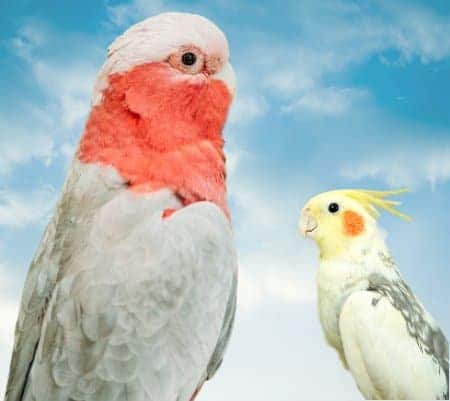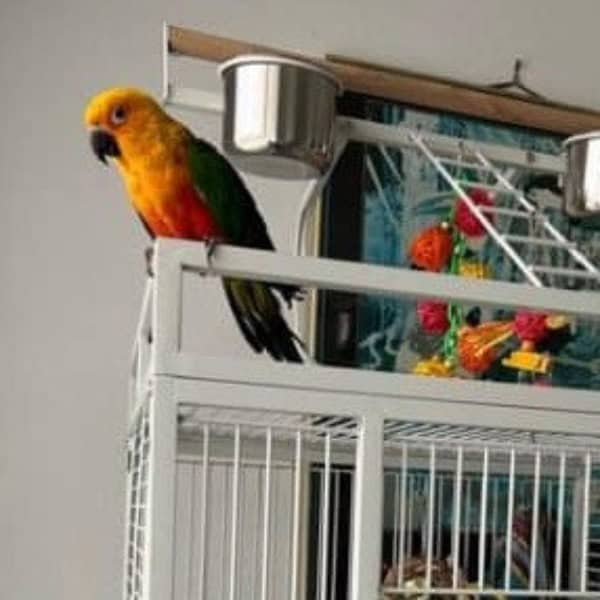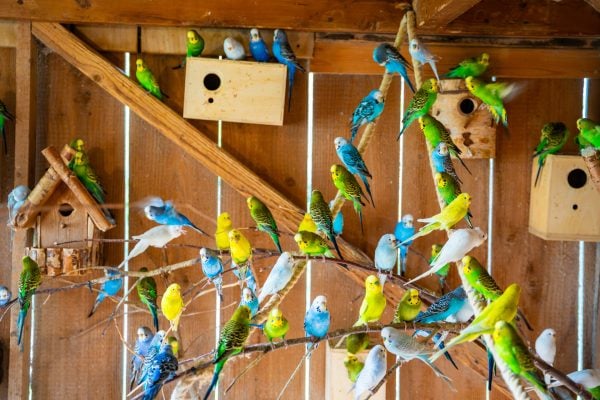Last Updated on by Mitch Rezman
In this post we have grouped together information requests specifically about cockatoo parrots.
For a more granular discussion about some of the many species of cockatoo parrots – click here
This post about cockatoos (we found 44 cockatoo species listed at the bottom of this post) and serves as a counterpoint to the 43 species of macaw parrots we discussed last week.
We found a mere 12 cockatiel mutations.
At what age will a cockatoo stop laying eggs?
Name: Margaret G, Filled out from page: Egg Laying cockatoo
Colorado (United States)
(when you reach out to us using the green button at the bottom of this site, the button knows what page you are on to help us better understand your query)
Margaret
Unfortunately, if a birds egg laying goes uninterrupted, that bird will die.
Are you giving your bird a calcium supplement daily? If no, please start immediately.
Are you petting your cockatoo below the neck? If so, it’s best to stop that human behavior.
Only pet your bird from the neck up as lower will stimulate them sexually and get their hormones rolling.
editors note: all species have an instinctive urge to breed. Your solo bird is no different. In their mind you are their mate.
Do you have any bedding, huts, piles of shredded paper in the birds cage? If so, remove them all. These are all material used in getting ready to have babies.
Do you have a cage light with a full spectrum bulb over the bird cage set to run 12 hours on and 12 hours off using a timer?
(figure 8 to 8 if the hours work for your lifestyle. if you sleep in, then set for later like 10 to 10.)
This aids in keeping your bird’s circadian rhythms synchronized. Unfamiliar light cycles are stressful and can trigger brooding activity.
12/12 hours of on/off light simulate “an equatorial light cycle”. Australia is closer to the equator than North America so an even day light/night light cycle is part of your bird’s instinctual expectations
Many humans succumb to the SAD disorder that makes us depressed in the winter with the shorter life cycles and dreary days.
This is what your bird experiences 12 months a year without the aid of artificial lighting over his or her cage on a timer.
We recommend NOT to have Lupron injected at the vet, Lupron has not been proven to work and can be detrimental to your birds health.
We recommend a 72 hour constant light treatment. For three* solid days and nights the cage light must stay on. The bird must be in the light (cage) day and night. Your bird may be loud at night but it is only for a few days. Your bird can come out and play during the day, but must be in the lit cage at night. * For severe hormonal cases a 7 day light treatment can be used.
The bird will eat, play and nap just fine. You can wrap the sides of the bird cage with a blanket or sheet if your bird is usually covered, but not the top where the light comes into the cage.
https://www.youtube.com/watch?v=WE3KR3eWQTc
This resets your birds circadian rhythm which controls and causes hormonal behavior. After three to seven days, your bird’s internal clock(s) is reset and your bird should lose interest in hormonal activity.
editors note: and become freakin’ normal!.
This costs nothing but time and perhaps a little sanity on your part but it works.
It may be needed to be repeated in 6 months or more if your bird continues to get stimulated.
I hope this helps and you get back to us as to your expereince.
Thank you
Catherine
Sharon D [email protected] via windycityparrot.net
9:04 AM (2 hours ago)
Hi. I need to give my lovebird calcium supplements because she had a soft shell egg and we ended up in the hospital for a night.
Fortunately, supplements and warmth enabled her to lay the egg. When she was discharged, the vet gave me a calcium mixture, but I have to fight with my bird to administer it. I asked the vet if an OTC supplement to mix in her food is as good, and she said to be sure it’s “bio-available”. Is there one you recommend that can be absorbed well?
thank you -Sharon
Name: Sharon Dipre
Filled out from page: https://windycityparrot.com/vitamins-c-484_653/liquid-calcium-plus-concentrate-from-morning-bird-4-oz-1183-ml-p-1263.html:
Location: California (United States)
Are mirrors detrimental to birds?
Someone once told me that they will not interact with you as much if you have mirrors in their cage.
I have a goffins cockatoo and a cockatiel that both love their mirrors, but they also love me so I don’t know if that is true. I have had my cockatoo for 35 years and I thought she just didn’t like men, but lo and behold, she loves the man I’m with now and I couldn’t be happier! She must be a very good judge of character as he is the one.
Hi Lynn
Mirrors may or may not cause a bird to bond with the mirror instead of you. But it can.
We don’t recommend them for this reason.
https://www.youtube.com/watch?v=meUz09L2lMk
We recommend them mainly for lonely birds, birds who are not social, birds that lost a mate, etc.
If it is working for your birds, don’t try to fix what works.
So glad your birds are happy and healthy.
Thank you
How does a cockatoo and a cockatiel differ? (still seeking the original poster – apologies)
First I am compelled to set the record straight. There are no 3 foot to 4 foot long cockatoos responding to an answer for this question on Quora .
A hyacinth macaw can grow to 44 to 48 inches long including it’s tail but an umbrella cockatoo its generally about 18 inches long and weighs approximately one and a half pounds.(560 g)
Cockatiels like cockatoos hark from the continent of Australia. Ironically cockatiels used to be classified as a crested or small cockatoos.
We recently posted a list of 43 macaw. The hahns or noble macaw is the smallest of the 43 much like a cockatiel being the smallest of the 30 or so speaking of cockatoos.
Now that scientists have gotten more granular about birds, cockatiels have been assigned to its own subfamily Nymphicinae making it the smallest of the cockatoo (Nymphicinae) family.
The ideal weight for a cockatiel is about 100 grams which is just over 3 ounces. Except for size there’s not a great difference between a cockatoo and a cockatiel. Cockatiels are technically classified as one of the 21 or so sub species of cockatoos.
Bigger birds will have bigger brains louder voices and greater appetites So I’d say the single biggest difference between the two is that each species of the larger cockatoos present themselves in several colors – pink, white, black or speckled.
Cockatiels Offer many more mutations like Cinnamon split to Pied – Cinnamon Pearl – Pied – Pastel Face – Cinnamon Pied – DYC Cinnamon Pearl Male – Yellow Cheek Cinnamon Pearl – White Face Cinnamon Pearl.
They all can be cared for in a similar way
from Wikipedia
There are about 44 different birds in the cockatoo family Cacatuidae including recognized subspecies. The current subdivision of this family is as follows:[Note 1]
Subfamily Nymphicinae
Subfamily Calyptorhynchinae: The black cockatoos
- Genus Calyptorhynchus (5 species)
- Subgenus Calyptorhynchus – black-and-red cockatoos
- Red-tailed black cockatoo, Calyptorhynchus banksii (Latham, 1790) (5 subspecies)
- Glossy black cockatoo, Calyptorhynchus lathami (Temminck, 1807) (3 subspecies)
- Subgenus Zanda – black-and-yellow/white cockatoos
- Yellow-tailed black cockatoo, Calyptorhynchus funereus (Shaw, 1794) (2–3 subspecies)
- Carnaby’s black cockatoo, Calyptorhynchus latirostris Carnaby, 1948
- Baudin’s black cockatoo, Calyptorhynchus baudinii Lear, 1832
- Subgenus Calyptorhynchus – black-and-red cockatoos
Subfamily Cacatuinae
- Tribe Microglossini: One genus with one species, the black palm cockatoo.
- Genus Probosciger
- Palm cockatoo, Probosciger aterrimus (Gmelin, 1788) (4 subspecies)
- Genus Probosciger
- Tribe Cacatuini: Four genera of white, pink and grey species.
- Genus Callocephalon
- Gang-gang cockatoo, Callocephalon fimbriatum (Grant, 1803)
- Genus Eolophus
- Genus Lophochroa
- Major Mitchell’s cockatoo (also Leadbeater’s cockatoo), Lophochroa leadbeateri (Vigors, 1831) (2 subspecies)
- Genus Cacatua (11 species)
- Subgenus Cacatua – true white cockatoos
- Yellow-crested cockatoo (also lesser sulphur-crested cockatoo), Cacatua sulphurea (Gmelin, 1788) (4 subspecies)
- Sulphur-crested cockatoo, Cacatua galerita (Latham, 1790) (4 subspecies)
- Blue-eyed cockatoo, Cacatua ophthalmica Sclater, 1864
- White cockatoo, Cacatua alba (Müller, 1776)
- Salmon-crested cockatoo, Cacatua moluccensis (Gmelin, 1788)
- Subgenus Licmetis – corellas
- Long-billed corella, Cacatua tenuirostris (Kuhl, 1820)
- Western corella, Cacatua pastinator (Gould, 1841) (2 subspecies)
- Little corella (also bare-eyed cockatoo), Cacatua sanguinea Gould, 1843 (4 subspecies)
- Tanimbar corella (also Goffin’s cockatoo), Cacatua goffiniana Roselaar and Michels, 2004[32]
- Solomons cockatoo, Cacatua ducorpsii Pucheran, 1853
- Red-vented cockatoo, Cacatua haematuropygia (Müller, 1776)
- Subgenus Cacatua – true white cockatoos
- Genus Callocephalon
end Wikipedia
Then there’s the rarer albino Cockatiel. This is popcorn RIP who passed over the rainbow bridge June of 2016 from cancer.
https://www.youtube.com/watch?v=qprARa9rWmI
In conclusion.
The better we understand the bird kingdom the better we begin to understand our own bird’s pecking order.
written by mitch rezman
approved by catherine tobsing
Author Profile
Latest entries
 The Traveling BirdJune 26, 2025Can You Name 5 Parrot Species That Are Living Wild in the USA?
The Traveling BirdJune 26, 2025Can You Name 5 Parrot Species That Are Living Wild in the USA? Bird BehaviorJune 26, 2025How is it Parrots Are Problem Solvers Social Animals and Even Use Tools?
Bird BehaviorJune 26, 2025How is it Parrots Are Problem Solvers Social Animals and Even Use Tools? Bird & Parrot AnatomyJune 25, 2025How a Tiny Chemical Modification Makes Parrots Nature’s Living Paintings
Bird & Parrot AnatomyJune 25, 2025How a Tiny Chemical Modification Makes Parrots Nature’s Living Paintings PigeonsJune 20, 2025How Do Parrots Thrive in Cities Outside Their Native Habitats?
PigeonsJune 20, 2025How Do Parrots Thrive in Cities Outside Their Native Habitats?




